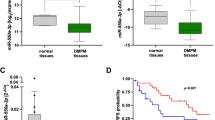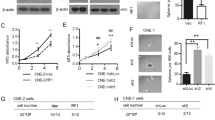Abstract
EphrinA1 binding with receptor EphA2 suppresses malignant mesothelioma (MM) growth. The mechanisms whereby EphrinA1 attenuates the MM cell (MMC) growth are not clear. In this study, we report that the activation of MMCs with EphrinA1 leads to an induction of let-7 microRNA (miRNA) expression, repression of RAS proto-oncogene and the attenuation of MM tumor growth. The expression of miRNAs was determined by reverse transcription-quantitative polymerase chain reaction and in situ hybridization. RAS expression was determined by q-PCR, western blotting and immunofluorescence. MMC proliferation and tumor growth were determined by WST-1 and Matrigel assay, respectively. EphrinA1 activation induced several fold increases in let-7a1, let-7a3, let-7f1 and let-7f2 miRNA expression in MMCs. In contrast, EphrinA1 activation significantly downregulated H-RAS, K-RAS and N-RAS expression and inhibited MMC proliferation and tumor growth. In MMCs transfected with 2′-O-methyl antisense oligonucleotides to let-7 miRNA, EphrinA1 activation failed to inhibit the proliferative response and tumor growth. In mismatch antisense oligonucleotide-treated MMCs, the proliferation and tumor growth were comparable to untreated proliferating cells. Furthermore, the transfection of MMCs with let-7a miRNA precursor inhibited RAS expression and attenuated MMC tumor growth. Our data revealed that EphrinA1 signaling induces let-7 miRNA expression and attenuates MM tumor growth by targeting RAS proto-oncogene in MMCs.
This is a preview of subscription content, access via your institution
Access options
Subscribe to this journal
Receive 12 print issues and online access
$259.00 per year
only $21.58 per issue
Buy this article
- Purchase on Springer Link
- Instant access to full article PDF
Prices may be subject to local taxes which are calculated during checkout






Similar content being viewed by others
References
Mutsaers SE . The mesothelial cell. Int J Biochem Cell Biol 2004; 36: 9–16.
Leppla SH, Arora N, Varughese M . Anthrax toxin fusion proteins for intracellular delivery of macromolecules. J Appl Microbiol 1999; 87: 284.
Murer B . Pleural malignant mesothelioma. Adv Clin Pathol 2000; 4: 177–179.
Baas P, Schouwink H, Zoetmulder FA . Malignant pleural mesothelioma. Ann Oncol 1998; 9: 139–149.
Moore S, Darlison L, Tod AM . Living with mesothelioma. A literature review. Eur J Cancer Care 2010; 19: 458–468.
Drescher U, Kremoser C, Handwerker C, Loschinger J, Noda M, Bonhoeffer F . In vitro guidance of retinal ganglion cell axons by RAGS, a 25 kDa tectal protein related to ligands for Eph receptor tyrosine kinases. Cell 1995; 82: 359–370.
Macrae M, Neve RM, Rodriguez-Viciana P, Haqq C, Yeh J, Chen C et al. A conditional feedback loop regulates Ras activity through EphA2. Cancer cell 2005; 8: 111–118.
McBride JL, Ruiz JC . Ephrin-A1 is expressed at sites of vascular development in the mouse. Mech Dev 1998; 77: 201–204.
Wykosky J, Debinski W . The EphA2 receptor and ephrinA1 ligand in solid tumors: function and therapeutic targeting. Mol Cancer Res 2008; 6: 1795–1806.
Noblitt LW, Bangari DS, Shukla S, Knapp DW, Mohammed S, Kinch MS et al. Decreased tumorigenic potential of EphA2-overexpressing breast cancer cells following treatment with adenoviral vectors that express EphrinA1. Cancer Gene Ther 2004; 11: 757–766.
Duxbury MS, Ito H, Zinner MJ, Ashley SW, Whang EE . Ligation of EphA2 by Ephrin A1-Fc inhibits pancreatic adenocarcinoma cellular invasiveness. Biochem Biophys Res Commun 2004; 320: 1096–1102.
Lai YM, Mohammed KA, Nasreen N, Baumuratov A, Bellew BF, Antony VB . Induction of cell cycle arrest and apoptosis by BCG infection in cultured human bronchial airway epithelial cells. Am J Physiol Lung Cell Mol Physiol 2007; 293: L393–L401.
Pratt RL, Kinch MS . Ligand binding up-regulates EphA2 messenger RNA through the mitogen-activated protein/extracellular signal-regulated kinase pathway. Mol Cancer Res 2003; 1: 1070–1076.
Self AJ, Caron E, Paterson HF, Hall A . Analysis of R-Ras signalling pathways. J Cell Sci 2001; 114: 1357–1366.
Patel MR, Jacobson BA, De A, Frizelle SP, Janne P, Thumma SC et al. Ras pathway activation in malignant mesothelioma. J Thorac Oncol 2007; 2: 789–795.
Eskandarpour M, Huang F, Reeves KA, Clark E, Hansson J . Oncogenic NRAS has multiple effects on the malignant phenotype of human melanoma cells cultured in vitro. Int J Cancer 2009; 124: 16–26.
Esquela-Kerscher A, Slack FJ . Oncomirs—microRNAs with a role in cancer. Nat Rev Cancer 2006; 6: 259–269.
Ricarte Filho JC, Kimura ET . MicroRNAs: novel class of gene regulators involved in endocrine function and cancer. Arq Bras Endocrinol Metabol 2006; 50: 1102–1107.
Lee RC, Feinbaum RL, Ambros V . The C. elegans heterochronic gene lin-4 encodes small RNAs with antisense complementarity to lin1–4. Cell 1993; 75: 843–854.
Johnson SM, Grosshans H, Shingara J, Byrom M, Jarvis R, Cheng A et al. RAS is regulated by the let-7 microRNA family. Cell 2005; 120: 635–647.
Reinhart BJ, Slack FJ, Basson M, Pasquinelli AE, Bettinger JC, Rougvie AE et al. The 21-nucleotide let-7 RNA regulates developmental timing in Caenorhabditis elegans. Nature 2000; 403: 901–906.
Miao H, Wei BR, Peehl DM, Li Q, Alexandrou T, Schelling JR et al. Activation of EphA receptor tyrosine kinase inhibits the Ras/MAPK pathway. Nat cell Biol 2001; 3: 527–530.
Nasreen N, Mohammed KA, Antony VB . Silencing the receptor EphA2 suppresses the growth and haptotaxis of malignant mesothelioma cells. Cancer 2006; 107: 2425–2435.
Fuentes-Calvo I, Blazquez-Medela AM, Santos E, Lopez-Novoa JM, Martinez-Salgado C . Analysis of k-ras nuclear expression in fibroblasts and mesangial cells. PloS one 2010; 5: e8703.
Hutvagner G, Simard MJ, Mello CC, Zamore PD . Sequence-specific inhibition of small RNA function. PLoS Biol 2004; 2: E98.
Bao S, Wang Y, Sweeney P, Chaudhuri A, Doseff AI, Marsh CB et al. Keratinocyte growth factor induces Akt kinase activity and inhibits Fas-mediated apoptosis in A549 lung epithelial cells. Am J Physiol Lung Cell Mol Physiol 2005; 288: L36–L42.
Nasreen N, Mohammed KA, Mubarak KK, Baz MA, Akindipe OA, Fernandez-Bussy S et al. Pleural mesothelial cell transformation into myofibroblasts and haptotactic migration in response to TGF-beta1 in vitro. Am J Physiol Lung Cell Mol Physiol 2009; 297: L115–L124.
de Planell-Saguer M, Rodicio MC, Mourelatos Z . Rapid in situ codetection of noncoding RNAs and proteins in cells and formalin-fixed paraffin-embedded tissue sections without protease treatment. Nat Protoc 2010; 5: 1061–1073.
Pass HI, Vogelzang N, Hahn S, Carbone M . Malignant pleural mesothelioma. Curr Probl Cancer 2004; 28: 93–174.
Noblitt LW, Bangari DS, Shukla S, Mohammed S, Mittal SK . Immunocompetent mouse model of breast cancer for preclinical testing of EphA2-targeted therapy. Cancer Gene Ther 2005; 12: 46–53.
Wohlfahrt JG, Karagiannidis C, Kunzmann S, Epstein MM, Kempf W, Blaser K et al. Ephrin-A1 suppresses Th2 cell activation and provides a regulatory link to lung epithelial cells. J Immunol 2004; 172: 843–850.
Wykosky J, Gibo DM, Debinski W . A novel, potent, and specific ephrinA1-based cytotoxin against EphA2 receptor expressing tumor cells. Mol Cancer Therap 2007; 6: 3208–3218.
Thirkettle I, Harvey P, Hasleton PS, Ball RY, Warn RM . Immunoreactivity for cadherins, HGF/SF, met, and erbB-2 in pleural malignant mesotheliomas. Histopathology 2000; 36: 522–528.
Pass HI, Robinson BW, Testa JR, Carbone M . Emerging translational therapies for mesothelioma. Chest 1999; 116: 455S–460S.
Barsky SH, Roth MD, Kleerup EC, Simmons M, Tashkin DP . Histopathologic and molecular alterations in bronchial epithelium in habitual smokers of marijuana, cocaine, and/or tobacco. J Natl Cancer Inst 1998; 90: 1198–1205.
Chin LJ, Ratner E, Leng S, Zhai R, Nallur S, Babar I et al. A SNP in a let-7 microRNA complementary site in the KRAS 3′ untranslated region increases non-small cell lung cancer risk. Cancer Res 2008; 68: 8535–8540.
Brannan JM, Dong W, Prudkin L, Behrens C, Lotan R, Bekele BN et al. Expression of the receptor tyrosine kinase EphA2 is increased in smokers and predicts poor survival in non-small cell lung cancer. Clin Cancer Res 2009; 15: 4423–4430.
Yanaihara N, Caplen N, Bowman E, Seike M, Kumamoto K, Yi M et al. Unique microRNA molecular profiles in lung cancer diagnosis and prognosis. Cancer Cell 2006; 9: 189–198.
Johnson CD, Esquela-Kerscher A, Stefani G, Byrom M, Kelnar K, Ovcharenko D et al. The let-7 microRNA represses cell proliferation pathways in human cells. Cancer Res 2007; 67: 7713–7722.
Takamizawa J, Konishi H, Yanagisawa K, Tomida S, Osada H, Endoh H et al. Reduced expression of the let-7 microRNAs in human lung cancers in association with shortened postoperative survival. Cancer Res 2004; 64: 3753–3756.
Guled M, Lahti L, Lindholm PM, Salmenkivi K, Bagwan I, Nicholson AG et al. CDKN2A, NF2, and JUN are dysregulated among other genes by miRNAs in malignant mesothelioma—a miRNA microarray analysis. Genes Chrom Cancer 2009; 48: 615–623.
Schultz J, Lorenz P, Gross G, Ibrahim S, Kunz M . MicroRNA let-7b targets important cell cycle molecules in malignant melanoma cells and interferes with anchorage-independent growth. Cell Res 2008; 18: 549–557.
Akao Y, Nakagawa Y, Naoe T . Let-7 microRNA functions as a potential growth suppressor in human colon cancer cells. Biol Pharmaceut Bull 2006; 29: 903–906.
Kumar MS, Erkeland SJ, Pester RE, Chen CY, Ebert MS, Sharp PA et al. Suppression of non-small cell lung tumor development by the let-7 microRNA family. Proc Natl Acad Sci USA 2008; 105: 3903–3908.
Lee YS, Dutta A . The tumor suppressor microRNA let-7 represses the HMGA2 oncogene. Genes Dev 2007; 21: 1025–1030.
Eder M, Scherr M . MicroRNA and lung cancer. N Engl J Med 2005; 352: 2446–2448.
Acknowledgements
This work was supported by NIR Grant no. 00079054; RC1 (no. 00083831) from Florida Department of Health (NN); and VA Merit Review (KAM). The technical assistance of Zita Burkhalter was greatly acknowledged.
Author information
Authors and Affiliations
Corresponding author
Ethics declarations
Competing interests
The authors declare no conflict of interest.
Rights and permissions
About this article
Cite this article
Khodayari, N., Mohammed, K., Goldberg, E. et al. EphrinA1 inhibits malignant mesothelioma tumor growth via let-7 microRNA-mediated repression of the RAS oncogene. Cancer Gene Ther 18, 806–816 (2011). https://doi.org/10.1038/cgt.2011.50
Received:
Revised:
Accepted:
Published:
Issue Date:
DOI: https://doi.org/10.1038/cgt.2011.50
Keywords
This article is cited by
-
Targeting EFNA1 suppresses tumor progression via the cMYC-modulated cell cycle and autophagy in esophageal squamous cell carcinoma
Discover Oncology (2023)
-
An integrated analysis of single-cell and bulk transcriptomics reveals EFNA1 as a novel prognostic biomarker for cervical cancer
Human Cell (2022)
-
K-Ras, H-Ras, N-Ras and B-Raf mutation and expression analysis in Wilms tumors: association with tumor growth
Medical Oncology (2017)
-
MicroRNA-let-7a promotes E2F-mediated cell proliferation and NFκB activation in vitro
Cellular & Molecular Immunology (2014)
-
Role of microRNAs in malignant mesothelioma
Cellular and Molecular Life Sciences (2014)



